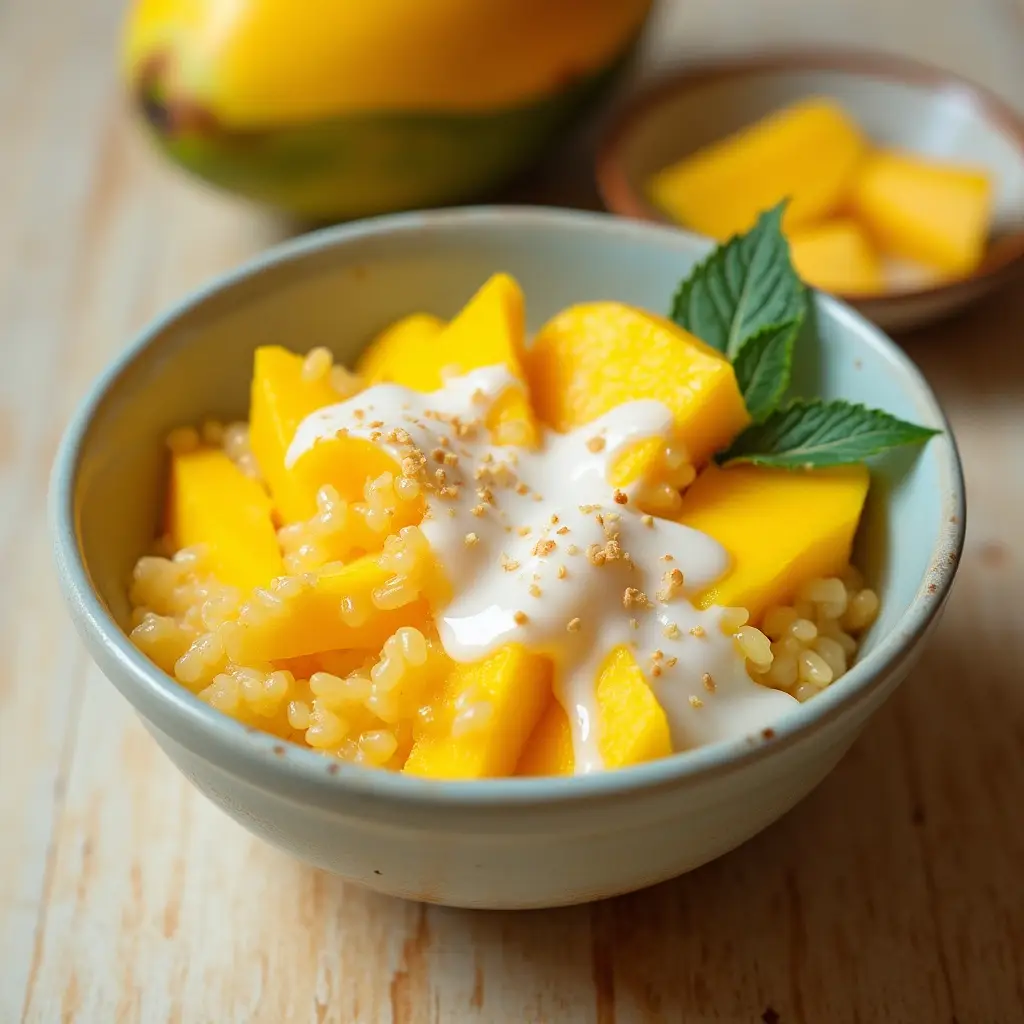
A Gluten-Free Take on a Classic Dessert
Craving a sweet and satisfying dessert that’s also gluten-free and vegan? Look no further! This recipe reimagines a beloved treat, offering a delightful combination of textures and flavors that will transport your taste buds. If you love experimenting with gluten-free rice-based desserts, you might also enjoy our Homemade Rasgulla recipe – another naturally gluten-free delight!
The Magic of Sticky Rice
The heart of this dessert lies in the unique texture of Thai sticky rice, also known as glutinous rice. Despite the name, it’s completely gluten-free! This special type of rice becomes wonderfully tender and slightly sticky when cooked, providing the perfect base for the creamy coconut sauce and sweet mangoes. Just be sure to use Thai long grain sticky rice for the best results; regular rice won’t have the same satisfying texture. For another way to use rice, try these easy 10 Gluten-Free Recipes For Beginners.
A Symphony of Flavors and Textures
What makes this dessert truly special is the interplay of flavors and textures. The sticky, creamy coconut rice complements the sweet and juicy mangoes perfectly. And the nutty topping adds a delightful crunch and savory element that elevates the entire experience. It’s a comforting and satisfying treat that’s surprisingly easy to make. Looking for another way to add some zest to your day? Try our Zesty Gluten-Free Lemon Bars!
Making Gluten-Free Thai Mango Sticky Rice
Here’s how to create this delicious gluten-free and vegan Thai Mango Sticky Rice. Follow these simple steps for a perfect dessert every time!
Step-by-Step Instructions:
1. Prepare the Sticky Rice:
- Rinse 1 cup of uncooked sticky rice (also known as glutinous rice) thoroughly under cold water.
- Soak the rinsed rice in water overnight, or for at least 8 hours. This step is crucial for achieving the right texture.
- After soaking, drain and rinse the rice again.
- Line a steamer pot with parchment paper or a thin cheesecloth. This prevents the rice from falling through the steamer basket.
- Place the rice in the prepared steamer. Steam for 20-25 minutes over medium heat, or until the rice becomes translucent and is still slightly chewy.
2. Prepare the Coconut Milk Sauce:
- In a small pot, combine one can of full-fat coconut milk, 1/3 cup plus 1 tablespoon of pure organic cane sugar, and 1/2 teaspoon of sea salt.
- Heat the mixture over medium heat, stirring frequently until it comes to a light boil.
- Reduce the heat to low and continue stirring until the sugar is completely dissolved.
- Remove 3/4 cup of the coconut sauce from the pot and set it aside. This portion will be mixed with the rice later.
- In a small bowl, whisk together 1 teaspoon of cornstarch with 2 tablespoons of water to create a slurry.
- Add the cornstarch slurry to the remaining coconut sauce in the pot.
- Bring the mixture to a gentle simmer, stirring continuously, until the sauce thickens slightly, about 2-3 minutes. The sauce should be thick enough to coat the back of a spoon. This thickened sauce will be used as a topping.
3. Combine Rice and Sauce:
- Transfer the steamed sticky rice to a mixing bowl.
- Pour the reserved 3/4 cup of coconut sauce over the rice.
- Gently mix until the rice is evenly coated with the sauce.
- Loosely cover the bowl with a clean towel and let it sit for 15 minutes. This allows the rice to absorb the coconut milk, making it creamy and flavorful.
4. Prepare the Garnish:
- In a small bowl, combine 1 tablespoon of dry-roasted crushed peanuts, 1/2 tablespoon of sesame seeds, 1 teaspoon of pure organic cane sugar, and 1/8 teaspoon of sea salt. Mix well.
5. Assemble and Serve:
- Scoop some of the coconut sticky rice onto a plate.
- Arrange slices of 2-3 ripe mangoes alongside the rice.
- Drizzle the thickened coconut sauce over the rice.
- Sprinkle the peanut-sesame seed garnish generously on top.
- Serve warm and enjoy immediately! This dessert is best when eaten fresh.
Enjoy your homemade Gluten-Free Thai Mango Sticky Rice!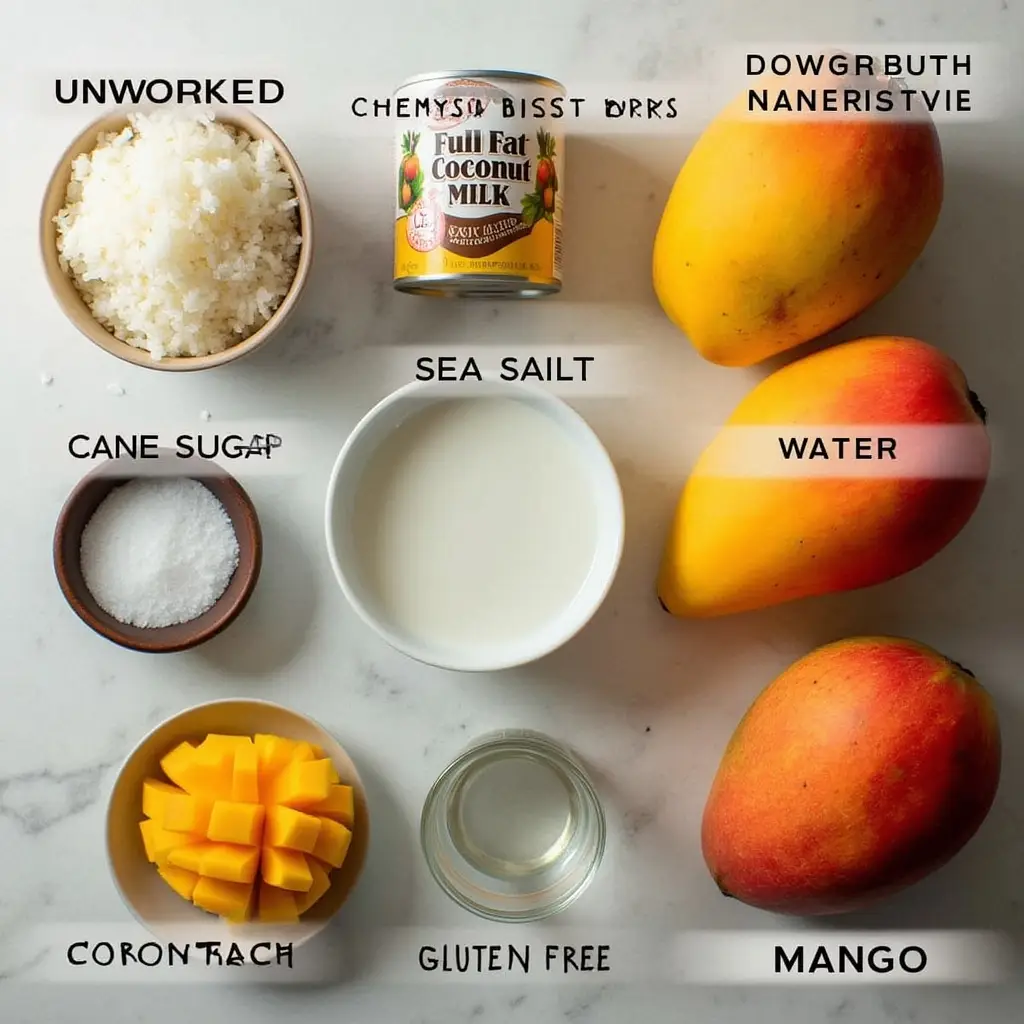
“`html
Ingredients
- 1 cup uncooked sticky rice or glutinous rice (rinsed and soaked overnight)
- 1 can full fat coconut milk
- 1/3 cup + 1 Tbsp pure organic cane sugar
- 1/2 tsp sea salt
- 1 tsp cornstarch
- 2 Tbsp water
- 2-3 ripe mangoes, peeled and sliced
Garnish/Topping
- 1 Tbsp dry roasted peanuts, crushed
- 1/2 Tbsp sesame seeds
- 1 tsp pure organic cane sugar
- 1/8 tsp sea salt
Nutritional Information: A Gluten-Free Delight
Our Thai Mango Sticky Rice recipe isn’t just delicious; it’s also naturally gluten-free! Made with glutinous rice (which, despite its name, contains no gluten), this dessert is a safe and delightful option for those with gluten sensitivities or celiac disease. Here’s a breakdown of the nutritional benefits:
- Gluten-Free Goodness: The base of this recipe, sticky rice, is naturally gluten-free, making it a perfect choice for those avoiding gluten.
- Healthy Fats: Coconut milk provides healthy fats that are beneficial for overall well-being.
- Natural Sweetness: We use pure organic cane sugar in moderation, allowing the natural sweetness of the mangoes to shine through.
- Vitamins and Minerals: Mangoes are packed with vitamins A and C, as well as fiber, contributing to a balanced dessert.
While we don’t have exact nutritional figures per serving, this dessert offers a balance of carbohydrates, healthy fats, and essential vitamins. Enjoy in moderation as part of a balanced diet.
Tips and Variations for the Best Gluten-Free Thai Mango Sticky Rice
Here are some helpful tips and variations to ensure your Thai Mango Sticky Rice is perfect every time:
Essential Tips for Success
- Rice Quality: Use high-quality Thai sticky rice (glutinous rice) for the best results. Ensure it is the long-grain variety for an authentic texture.
- Soaking Time: Don’t skip the soaking process! Soaking the rice overnight is crucial for achieving the right sticky texture.
- Steaming Perfection: Steam the rice until it is translucent and chewy. This usually takes about 20-25 minutes.
- Coconut Milk Consistency: Full-fat coconut milk is essential for the creamy, rich sauce that makes this dessert so indulgent.
- Mango Ripeness: Use ripe, sweet mangoes for the best flavor. The sweetness of the mangoes complements the sticky rice perfectly.
Dietary Variations
- Lower Sugar: Reduce the amount of added sugar and let the natural sweetness of the mangoes be the star.
- Alternative Sweeteners: Experiment with alternative sweeteners like coconut sugar or maple syrup for a different flavor profile.
- Nut-Free Topping: If you have a nut allergy, skip the peanut garnish or replace it with toasted coconut flakes or sunflower seeds.
- Vegan Option: This recipe is already vegan-friendly, making it accessible to a wide range of dietary preferences.
Serving Suggestions
- Warm Delight: Serve the Thai Mango Sticky Rice warm for the best experience.
- Fresh is Best: Enjoy this dessert fresh for optimal flavor and texture.
- Garnish Creatively: Get creative with your garnish! Add a sprinkle of toasted sesame seeds, a drizzle of extra coconut milk, or a pinch of sea salt to enhance the flavors.
Enjoy creating this classic Thai dessert in your own kitchen! With these tips and variations, you can customize it to suit your taste and dietary needs. Happy cooking!
Essential Equipment for This Recipe
To prepare this delicious recipe, you’ll need the following kitchen tools:
- Mixing Bowls – A set of good quality mixing bowls is essential for combining wet and dry ingredients.
Find Mixing Bowls on Amazon - Measuring Cups and Spoons – Accurate measurements are key to successful baking!
Find Measuring Cups and Spoons on Amazon - Baking Sheets – For evenly baked goods.
Find Baking Sheets on Amazon - Whisks – Perfect for whipping cream or egg whites.
Find Whisks on Amazon - Spatulas – Use these to gently fold ingredients together.
Find Spatulas on Amazon - Food Processors – A good food processor can make prepping ingredients much faster.
Find Food Processors on Amazon - Saucepans – A saucepan is essential for cooking or heating liquids and sauces.
Find Saucepans on Amazon - Chef’s Knives – A good chef’s knife is crucial for safe and efficient prep work.
Find Chef’s Knives on Amazon - Cutting Boards – A sturdy cutting board protects your countertops and provides a safe surface for chopping.
Find Cutting Boards on Amazon

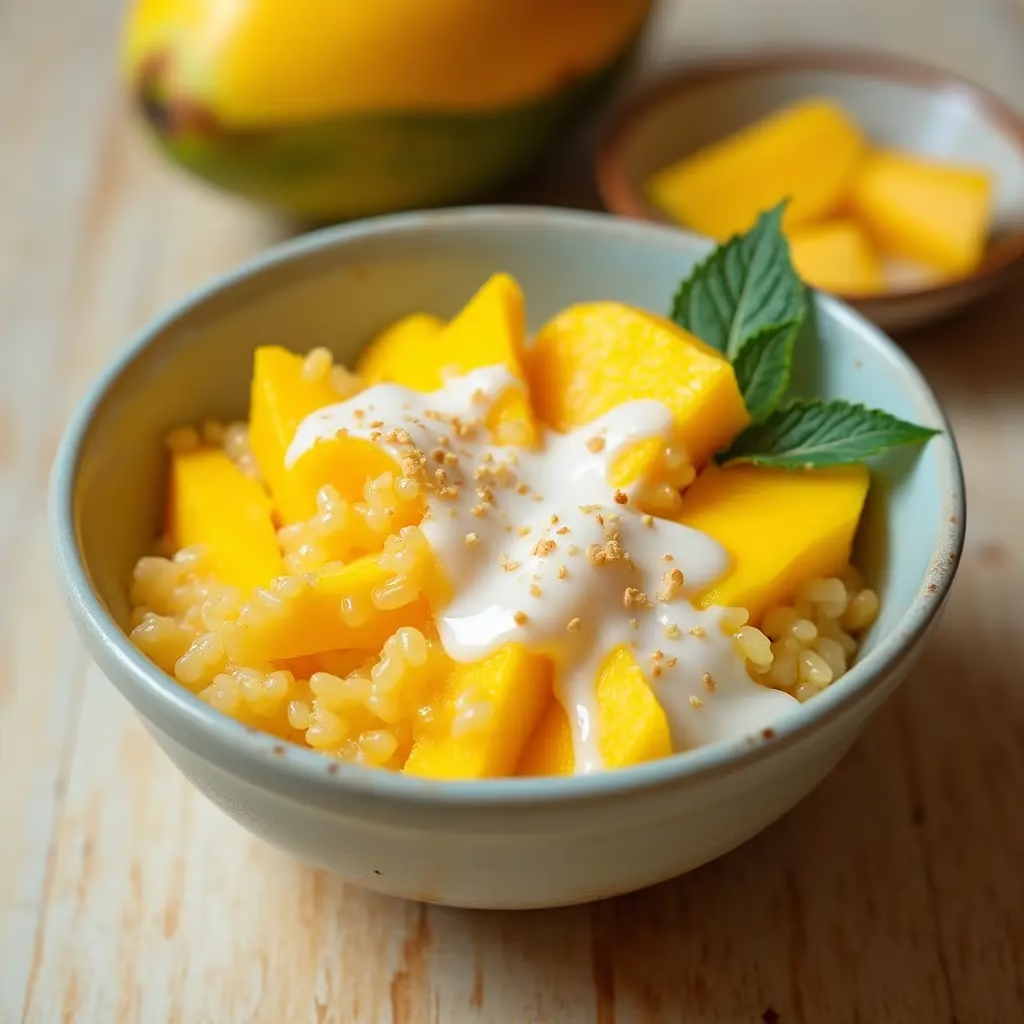
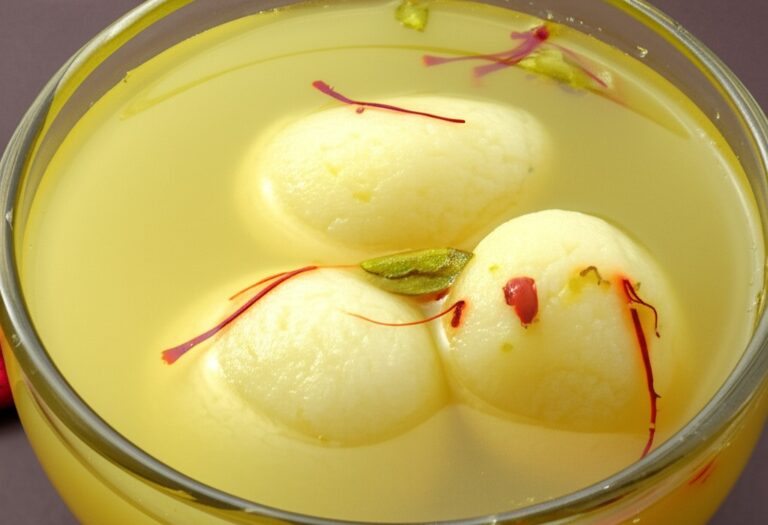
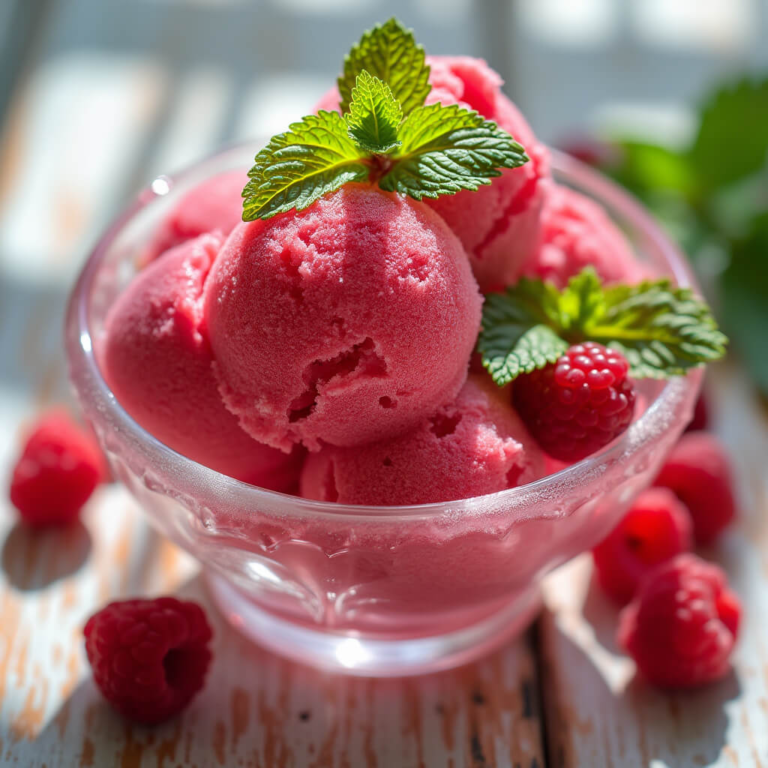

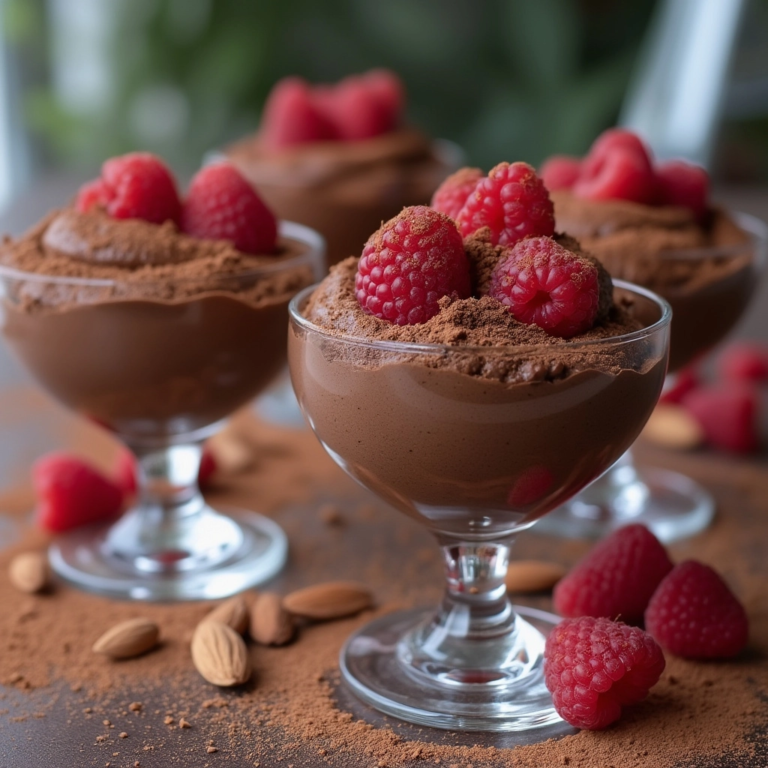
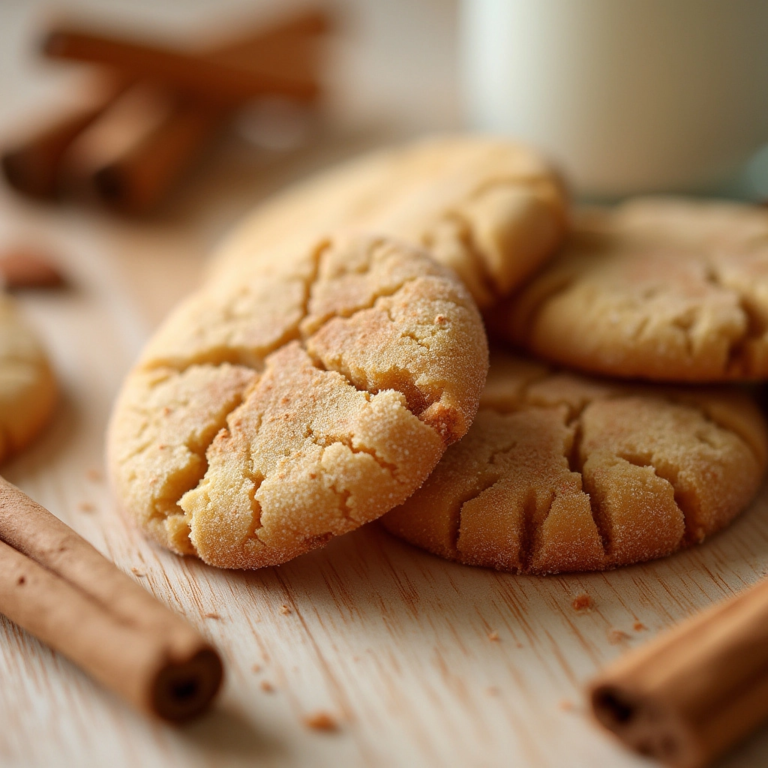

One Comment